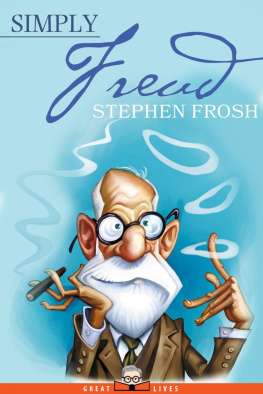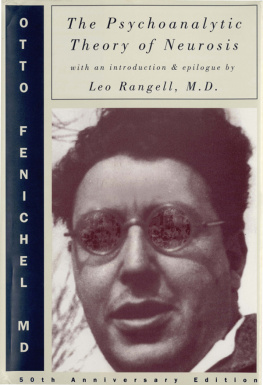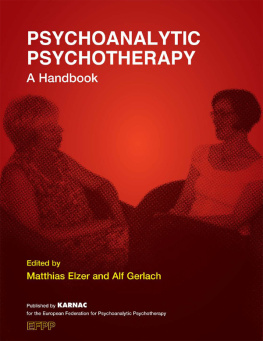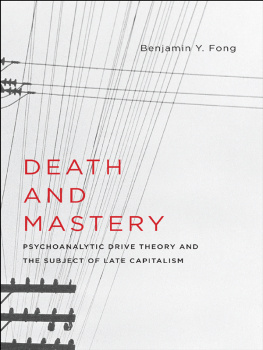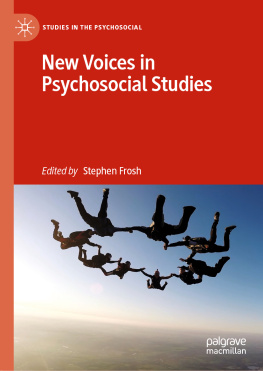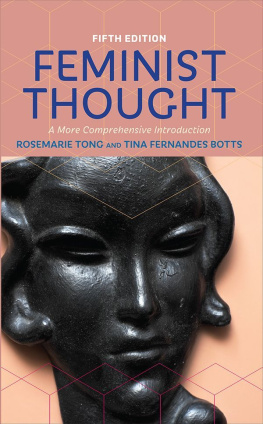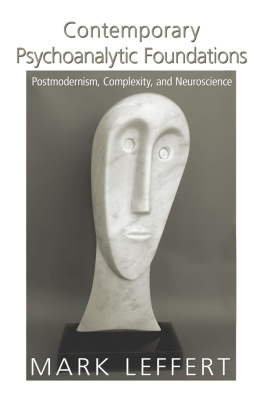Frosh - A Brief Introduction to Psychoanalytic Theory
Here you can read online Frosh - A Brief Introduction to Psychoanalytic Theory full text of the book (entire story) in english for free. Download pdf and epub, get meaning, cover and reviews about this ebook. City: Basingstoke, year: 2012, publisher: Palgrave Macmillan Ltd., genre: Religion. Description of the work, (preface) as well as reviews are available. Best literature library LitArk.com created for fans of good reading and offers a wide selection of genres:
Romance novel
Science fiction
Adventure
Detective
Science
History
Home and family
Prose
Art
Politics
Computer
Non-fiction
Religion
Business
Children
Humor
Choose a favorite category and find really read worthwhile books. Enjoy immersion in the world of imagination, feel the emotions of the characters or learn something new for yourself, make an fascinating discovery.

A Brief Introduction to Psychoanalytic Theory: summary, description and annotation
We offer to read an annotation, description, summary or preface (depends on what the author of the book "A Brief Introduction to Psychoanalytic Theory" wrote himself). If you haven't found the necessary information about the book — write in the comments, we will try to find it.
Frosh: author's other books
Who wrote A Brief Introduction to Psychoanalytic Theory? Find out the surname, the name of the author of the book and a list of all author's works by series.
A Brief Introduction to Psychoanalytic Theory — read online for free the complete book (whole text) full work
Below is the text of the book, divided by pages. System saving the place of the last page read, allows you to conveniently read the book "A Brief Introduction to Psychoanalytic Theory" online for free, without having to search again every time where you left off. Put a bookmark, and you can go to the page where you finished reading at any time.
Font size:
Interval:
Bookmark:

Also by Stephen Frosh:
Feelings
Psychoanalysis outside the Clinic: Interventions in Psychosocial Studies*
For and Against Psychoanalysis
Hate and the Jewish Science: Anti-Semitism, Nazism and Psychoanalysis*
Critical Narrative Analysis in Psychology (with Peter Emerson)*
Key Concepts in Psychoanalysis
After Words: The Personal in Gender, Culture and Psychotherapy*
Young Masculinities: Understanding Boys in Contemporary Society (with Ann Phoenix and Rob Pattman)*
The Politics of Psychoanalysis*
Sexual Difference: Masculinity and Psychoanalysis
Child Sexual Abuse (with Danya Glaser)*
Identity Crisis: Modernity, Psychoanalysis and the Self*
Psychoanalysis and Psychology*
*Also published by Palgrave Macmillan
Theory


Stephen Frosh 2012
All rights reserved. No reproduction, copy or transmission of this publication may be made without written permission.
No portion of this publication may be reproduced, copied or transmitted save with written permission or in accordance with the provisions of the Copyright, Designs and Patents Act 1988, or under the terms of any licence permitting limited copying issued by the Copyright Licensing Agency, Saffron House, 610 Kirby Street, London EC1N 8TS.
Any person who does any unauthorized act in relation to this publication may be liable to criminal prosecution and civil claims for damages.
The author has asserted his right to be identified as the author of this work in accordance with the Copyright, Designs and Patents Act 1988.
First published 2012 by
PALGRAVE MACMILLAN
Palgrave Macmillan in the UK is an imprint of Macmillan Publishers Limited, registered in England, company number 785998, of Houndmills, Basingstoke, Hampshire RG21 6XS.
Palgrave Macmillan in the US is a division of St Martins Press LLC, 175 Fifth Avenue, New York, NY 10010.
Palgrave Macmillan is the global academic imprint of the above companies and has companies and representatives throughout the world.
Palgrave and Macmillan are registered trademarks in the United States, the United Kingdom, Europe and other countries.
ISBN-13: 9780230369290 hardback
ISBN-13: 9780230369306 paperback
This book is printed on paper suitable for recycling and made from fully managed and sustained forest sources. Logging, pulping and manufacturing processes are expected to conform to the environmental regulations of the country of origin.
A catalogue record for this book is available from the British Library.
A catalog record for this book is available from the Library of Congress.
10 9 8 7 6 5 4 3 2 1
21 20 19 18 17 16 15 14 13 12
Printed in China
I would like especially to thank Catherine Gray at Palgrave Macmillan, who insisted that I write this book and provided an extraordinary editorial service. Most of the good things in the book are a result of her advice.
Thanks also to Joel and Alec, who encouraged me to produce this book for people like them.
Every effort has been made to trace all copyright holders, but if any have been inadvertently overlooked, the publishers would be pleased to make the necessary arrangements at the first opportunity.
Psychoanalysis can claim to be one of the most influential intellectual and practical projects of modern times. It was invented by Sigmund Freud and others towards the end of the nineteenth century, during the same period that other major social sciences (including psychology and sociology) were coming into being. It rapidly became prominent in clinical, academic and artistic circles and in some branches of commerce, notably advertising and public relations (Zaretsky, 2004). Psychoanalysis was also a major spur to the professions of psychotherapy and counselling that grew up in the twentieth century. It had a dramatic impact on treatment methods and was especially important in advancing the psychological therapy of shell-shocked patients during both World Wars. Many of its ideas became part of the taken-for-granted psychological understanding that people have about themselves and others. This applies especially to the proposal that peoples behaviour is strongly affected by unconscious impulses about which they know little and over which they have only limited control. The belief that talking about psychological problems might help a person deal with them, or that our dreams might reveal something about our deep wishes and conflicts, or that slips of the tongue might have significance, is premised on a generally psychoanalytic understanding about how the unconscious works. Ways of thinking about child development, about intimate relationships and about the meaning of psychological symptoms have all been profoundly affected by psychoanalytic theories.
Despite this extensive influence, the standing of psychoanalysis as a discipline possessing valid knowledge about human psychology remains uncertain. Freud claimed that psychoanalysis was a science and that its value lay in the way in which it identified the real sources of psychological life. This has always been heavily debated, with several writers raising serious doubts about whether psychoanalysis ever fulfilled the requirements of scientific practice (for example Borch-Jacobsen and Shamdasani, 2012) or whether it has been supported or disproven by evidence (Grnbaum, 1984). Defenders of psychoanalysis have argued that many of these critics have used a very idealized version of science in order to make their point, and also that psychoanalysis actually does have rational and testable approaches to knowledge, shown in the laboratory of the consulting room and in its growing openness to scrutiny in terms of reports and discussions of its clinical work (Frosh, 2006). For yet others, psychoanalysis is seen more as an artistic or humanistic approach to imaginative understanding, and does not need to pretend to be a science in order to have validity.
There is also something more general to say about the standing of psychoanalysis. This is a slightly complicated idea that has to do with what is called the reflexivity of human beings. What this refers to is the way in which people seek meaning through interpreting their own actions and thoughts and those of others. Humans can perhaps be seen as meaning-making machines. The argument here is that one universal characteristic of people is that they try to find ways to work out what they are about and on the whole that they do this in the context of their relationships with others. We go through life reflecting on ourselves to a greater or lesser extent; and it not only a psychoanalytic truism to think that the depth and extent of someones capacity for such reflection might be a measure of their standing as a person.
How do we make sense of ourselves? It has to be through drawing on our experiences and our behaviour and employing the ideas that can be found around us in our culture to help us interpret these. Among these ideas are some that derive from psychoanalysis, which we might use even if we have never read any psychoanalytic theory. For instance, the notion that childhood experiences matter for the way in which we later form relationships as adults is a very widespread one. The failure to make good relationships might be interpreted as a consequence of difficulties we had with our parents, maybe because we had an abandoning and rejecting father or a depressed and unresponsive mother. It is not necessary to know any psychoanalytic theory to hold this view; but psychoanalysis speaks cogently to it and provides a framework to support and consolidate such lay understandings.
Font size:
Interval:
Bookmark:
Similar books «A Brief Introduction to Psychoanalytic Theory»
Look at similar books to A Brief Introduction to Psychoanalytic Theory. We have selected literature similar in name and meaning in the hope of providing readers with more options to find new, interesting, not yet read works.
Discussion, reviews of the book A Brief Introduction to Psychoanalytic Theory and just readers' own opinions. Leave your comments, write what you think about the work, its meaning or the main characters. Specify what exactly you liked and what you didn't like, and why you think so.


